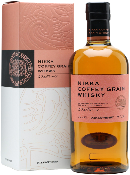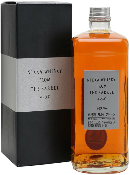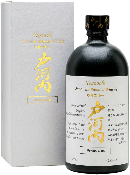Cellars: £69.50
 The nose is very complex and tends to drift. Cedar cigar-
The nose is very complex and tends to drift. Cedar cigar-
Taste with water
NOSE: fresh and enticing, it reveals ripe pear, cherry and exotic fruit aromas. Citrus notes of blood orange and lemon appear, slowly giving way to more subtle floral scents. With air, aromas of pastry, coconut and bourbon vanilla emerge, with underlying notes of mint and a hint of musk.
PALATE: juicy and pleasant, the promises of the nose are kept. Intense ripe fruit with rum accents (banana) and caramel. The complexity develops with hints of liquorice and star anise. The mid-
BODY: Light to medium
FINISH: just as pleasant as on the palate with pear and vanilla bourbon, ending on a very nice light bitter touch.
STYLE: fresh and enticing, it reveals ripe pear, cherry and exotic fruit aromas. Citrus notes of blood orange and lemon appear, slowly giving way to more subtle floral scents. With air, aromas of pastry, coconut and bourbon vanilla emerge, with underlying notes of mint and a hint of musk.
Food Pairings: Chocolate or fruit desserts
Recommended Serves ; Straight, on the rocks, or cocktails.
Country: Japan
Region: Miyagikyo Distillery, North of Honshu Island
Producer: The Nikka Whisky Distilling Co
Range: Single Grain Whisky
Bottling: Distillery Bottled
Style: Grain Whisky
Water Source: River Nikkawa
Owner: Nikka Whisky
Status: Operational
Age: Age not specified
Cask Type: Bourbon casks
Colour: Golden Hue
Flavour Profile: Tropical Fruits
Allergens: Not known
Bottle size: 70cl
abv: 45.0% abv
Tasting Notes
Distillery Information
HISTORY
In 1918, a young Japanese man with an ambition to make genuine whisky went alone to Scotland to unveil the secret of whisky making. He is Masataka Taketsuru, the founder of Nikka Whisky.
Given the chance to go to Scotland, Masataka became the first Japanese ever to master how to make whisky. He enrolled at the University of Glasgow, took chemistry courses and then apprenticed at three Scotch distilleries. The young and passionate man was fortunate to learn first-
Father of Japanese Whisky Masataka Taketsuru (1894-
Given the chance to go to Scotland, Masataka became the first Japanese ever to master how to make whisky. He enrolled at the University of Glasgow, took chemistry courses and then apprenticed at three Scotch distilleries. The young and passionate man was fortunate to learn first-
In 1920 Masataka returned to Japan with his Scottish wife Jessie Roberta (Rita). The two had married earlier that year and Rita decided to immigrate to Japan to support her husband’s dream. However after returning to Japan, Masataka and Rita were heartbroken to find out that Settsu Shuzo, the company which invested in Masataka to learn in Scotland, had to abandon its plan to produce genuine whisky in Japan due to recessions after World War I.
In the meantime another company, Kotobukiya Limited (Suntory), was in search for someone who could conduct whisky production. Being the only Japanese who knew how to produce whisky at that time, Masataka was hired by Kotobukiya in 1923 to direct building the Yamazaki Distillery. There he led the project and devoted himself to producing Japan’s first genuine whisky.
After his ten year contract with Kotobukiya, Masataka decided to become independent to make his own ideal whisky. In 1934 he went north and built his first distillery in Yoichi, Hokkaido, a place -
The company first started producing apple products under the name of “Dai Nippon Kaju”, meaning the “Great Japanese Juice Company” while he was preparing to produce whisky. In 1936 the first pot still designed by Masataka and made in Japan was installed and started distillation. Finally in 1940 the first whisky from Nikka was launched. The brand name of this whisky was “NIKKA WHISKY”, short for "Nippon Kaju", which later became the name of the company itself.
Masataka Taketsuru, the first Japanese who mastered whisky making in Scotland, valued the climate and natural features of the north. Yoichi, the place chosen by Masataka was close to the sea, surrounded by mountains on three sides and in many ways similar to Highland in Scotland. A cold climate with an appropriate humidity, crisp clean air and fresh water -
Direct coal-
The tradition inherited from the foundation
Masataka set a pot still using direct coal-
Miyagikyo Distillery
At latitude 38.3°N. A beautiful glen in the northern mountains the destination after pursuing an ideal location
Masataka aimed to make his blend more complex by widening the variety of whiskies. In 1967 he was exploring the northern part of the main island to find another ideal site for his second distillery. He came across a beautiful foggy glen surrounded by mountains and at a junction of two clean rivers. Once he tried the water from one of the rivers, which is now the water source, he was so impressed and immediately decided to build a distillery there. The name of the river was Nikkawa river by coincidence.
Malt whiskies reflecting different distillation methods
Masataka aimed to develop a complete contrast between Yoichi Distillery and Miyagikyo Distillery. Along with the different terroir, the different distillation method of Miyagikyo creates distinctive malt whiskies. Miyagikyo’s pot stills are much larger than those at Yoichi with different shapes such as a bulge neck and ascending lyne-
Miyagikyo Distillery produces grain whisky as well as malt whisky. The quality of grain whisky was one of the critical elements for Masataka’s ideal blending.
The Coffey Still is a very traditional type of a continuous still, which was invented by Mr. Aeneas Coffey in 1830. Masataka became familiar with the Coffey Still during his time at Bo’ness in Scotland and imported the first set in 1963. Despite its old-
*The Coffey Stills were first installed at the Nishinomiya plant and later transferred to Miyagikyo Distillery in 1999.
Coffey Grain is predominantly made from corn and distilled in a Coffey Still.
The complex, sweet and mellow flavours of this expression will help you re-
An essential component of Nikka Whisky’s blends, the Coffey Grain is a single grain whisky, distilled mainly from corn in a Coffey still located at the Miyagikyo distillery.
Cellars: £51.50
 The nose is very complex and tends to drift. Cedar cigar-
The nose is very complex and tends to drift. Cedar cigar-
Taste with water
NOSE: Refined and complex, floral notes of lilac, apricot. Spicy notes of clove with some leather appearing.
PALATE: Powerful and firm, pepper, oak aromas evolving on ripe fruits – peaches – caramelised apple and flowers of honeysuckle.
BODY: Medium
FINISH: Long coastal aromas, ripe fruits of prunes and peaches on a background of infused vanilla.
STYLE: Full and Rich
Country: Japan
Region:
Yoichi Distillery – Northern island of Hokkaido
Miyagikyo Distillery – North of Honshu Island
Producer: The Nikka Whisky Distilling Co
Range: The Core Range
Bottling: Distillery Bottled
Style: Double Matured Blended
Water Source: Own underground water source that is filtered through peat
Owner: Nikka Whisky
Status: Operational
Age: Age not specified
Cask Type: Bourbon and Sherry casks
Colour: Copper with a golden hue
Flavour Profile: Rich and fruity
Allergens: Not known
Bottle size: 50cl
abv: 51.4% abv
Distillery Information
Nikka is famous for its coveted single malts, but Nikka From The Barrel is a complex blended whisky that was specifically created to offer full flavors and richness and is compiled from more than 100 different malt and grain whiskies, all produced at Nikka’s Yoichi and Miyagikyo distilleries. These have been aged in multiple types of ex-
From The Barrel is an extremely complex blended whisky bottled at 51.4% ABV. In order to deliver its richness and full flavours, the blended liquid goes into used barrels for another few months for “marriage” before it is bottled
The iconic bottle is designed to reflect “a small block of whisky” – embodying the rich, strong taste of the whisky within.
HISTORY
In 1918, a young Japanese man with an ambition to make genuine whisky went alone to Scotland to unveil the secret of whisky making. He is Masataka Taketsuru, the founder of Nikka Whisky.
Given the chance to go to Scotland, Masataka became the first Japanese ever to master how to make whisky. He enrolled at the University of Glasgow, took chemistry courses and then apprenticed at three Scotch distilleries. The young and passionate man was fortunate to learn first-
Father of Japanese Whisky Masataka Taketsuru (1894-
Given the chance to go to Scotland, Masataka became the first Japanese ever to master how to make whisky. He enrolled at the University of Glasgow, took chemistry courses and then apprenticed at three Scotch distilleries. The young and passionate man was fortunate to learn first-
In 1920 Masataka returned to Japan with his Scottish wife Jessie Roberta (Rita). The two had married earlier that year and Rita decided to immigrate to Japan to support her husband’s dream. However after returning to Japan, Masataka and Rita were heartbroken to find out that Settsu Shuzo, the company which invested in Masataka to learn in Scotland, had to abandon its plan to produce genuine whisky in Japan due to recessions after World War I.
In the meantime another company, Kotobukiya Limited (Suntory), was in search for someone who could conduct whisky production. Being the only Japanese who knew how to produce whisky at that time, Masataka was hired by Kotobukiya in 1923 to direct building the Yamazaki Distillery. There he led the project and devoted himself to producing Japan’s first genuine whisky.
After his ten year contract with Kotobukiya, Masataka decided to become independent to make his own ideal whisky. In 1934 he went north and built his first distillery in Yoichi, Hokkaido, a place -
The company first started producing apple products under the name of “Dai Nippon Kaju”, meaning the “Great Japanese Juice Company” while he was preparing to produce whisky. In 1936 the first pot still designed by Masataka and made in Japan was installed and started distillation. Finally in 1940 the first whisky from Nikka was launched. The brand name of this whisky was “NIKKA WHISKY”, short for "Nippon Kaju", which later became the name of the company itself.
Yoichi Distillery
At Latitude 43.2°N
The harsh and rich nature in the north satisfying everything needed for whisky making
Masataka Taketsuru, the first Japanese who mastered whisky making in Scotland, valued the climate and natural features of the north. Yoichi, the place chosen by Masataka was close to the sea, surrounded by mountains on three sides and in many ways similar to Highland in Scotland. A cold climate with an appropriate humidity, crisp clean air and fresh water -
Direct coal-
The tradition inherited from the foundation
Masataka set a pot still using direct coal-
Miyagikyo Distillery
At latitude 38.3°N. A beautiful glen in the northern mountains the destination after pursuing an ideal location
Masataka aimed to make his blend more complex by widening the variety of whiskies. In 1967 he was exploring the northern part of the main island to find another ideal site for his second distillery. He came across a beautiful foggy glen surrounded by mountains and at a junction of two clean rivers. Once he tried the water from one of the rivers, which is now the water source, he was so impressed and immediately decided to build a distillery there. The name of the river was Nikkawa river by coincidence.
Malt whiskies reflecting different distillation methods
Masataka aimed to develop a complete contrast between Yoichi Distillery and Miyagikyo Distillery. Along with the different terroir, the different distillation method of Miyagikyo creates distinctive malt whiskies. Miyagikyo’s pot stills are much larger than those at Yoichi with different shapes such as a bulge neck and ascending lyne-
Miyagikyo Distillery produces grain whisky as well as malt whisky. The quality of grain whisky was one of the critical elements for Masataka’s ideal blending.
The Coffey Still is a very traditional type of a continuous still, which was invented by Mr. Aeneas Coffey in 1830. Masataka became familiar with the Coffey Still during his time at Bo’ness in Scotland and imported the first set in 1963. Despite its old-
*The Coffey Stills were first installed at the Nishinomiya plant and later transferred to Miyagikyo Distillery in 1999.
When a malt whisky and a grain whisky come of age, leave the casks they’ve called home, and fall in love, they get “married” -
Togoushi
Premium Blended Whisky
Cellars: £55.50
 Togouchi Blended whisky with malt and grain being used. It has peaty notes with chocolate, whilst the grain adds sweeter notes to the balance of the whisky, honey and gentle spice.
Togouchi Blended whisky with malt and grain being used. It has peaty notes with chocolate, whilst the grain adds sweeter notes to the balance of the whisky, honey and gentle spice.
Taste with water
NOSE: A frank and elegant nose, with notes of hazelnut and freshly-
PALATE: It’s has a light and mild taste. A sweet aroma that reminds you of grains and honey, with tones of white pepper and nutmeg, giving a mellow feeling
BODY: Light to medium
FINISH: Smooth and spiced , the slightly peaty aroma dominates the aftertaste.
STYLE: Easy drinking
Food Pairings: Chocolate
Recommended Serves: Straight, on the rocks.
Country: Japan
Region: Hiroshima
Producer: Chugoku Jozo
Range: The Core Range
Bottling: Distillery Bottled
Style: Blended Whiskey
Water Source: Not knowna
Owner: Chugoku Jozo
Status: Operational
Age: Age not specified
Cask Type: Bourbon casks
Colour: A light Golden Colour
Flavour Profile: Dairy
Allergens: Not known
Bottle size: 70cl
abv: 45.0% abv
Distillery Information
HISTORY
Togouchi is a blended Japanese whisky from the producers Chugoku Jozo, who mature their whisky in a tunnel rather than a warehouse. The name comes from where the tunnel is located, in the town of Togouchi, which merged with two other towns to create a larger town called Akiota.
This is their no-
Situated in the mountain area of Nishi Chugoki Sanchihi, where there was once built a tunnel for a train, but the project was never completed. Now Chugoku Jozo uses that 362 meter long tunnel for maturation which offers a constant temperature of 14c and a humidity level of 80%.
What we know is that this whisky is not distilled in Japan! This blend is in fact composed from imported Scottish malt and Canadian grain. Once Chugoku Jozo has paid the import duties and put the casks in their tunnel for maturation, they are naturalized to Japanese whisky.
Togouchi Premium marries Scottish heritage with Japanese blending knowledge from Chugoku Jozo. It is a well-
Japanese whisky came from scotch whisky.
The unique aroma of peat from scotch whisky is not often liked by Japanese people, so Togochi whisky is blended with a mild finish and some peat aroma to suit Japanese people’s taste.
A grain whisky with different features (an unblended whisky with a soft sweetness and an unblended whisky with rich minerals and grains) blends a well balanced peat aroma and a malt whisky that has a soft sweetness like vanilla and chocolate. Utilize the youthfulness, the whisky has been finished with a light flavour but comes with a kick.